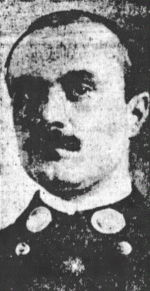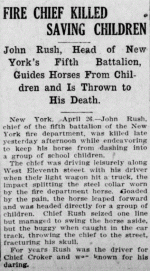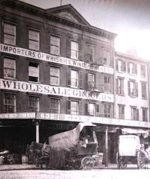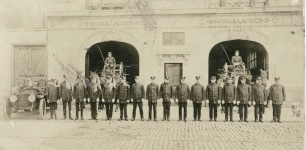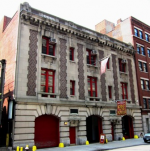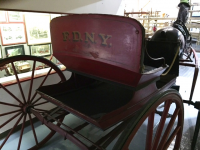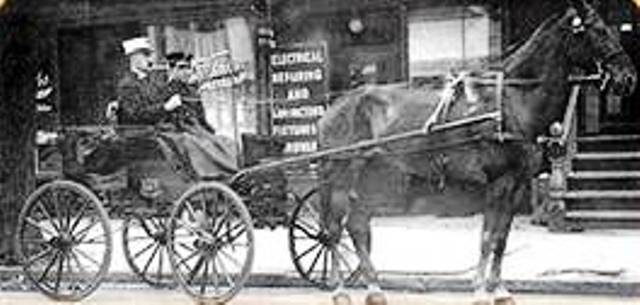True and Unusual Animal Tales of Old New York
Posted: 10th June 2015 by
The Hatching Cat in
FDNY Horses/Mascots,
Horse Tales
Tags:
Battalion Chief John Rush,
Chief Edward Croker,
FDNY,
fire horse,
New York Fire Patrol
1
 Chief Edward Croker (white hat) and his driver John Rush sometime in the early 1900s – I believe the horse in this photo was named Bullet. By this time chiefs in the FDNY were using automobiles to respond to fires, but a few horse-drawn buggies were kept in reserve because motorized vehicles were not always reliable. New York City Fire Museum Collections
Chief Edward Croker (white hat) and his driver John Rush sometime in the early 1900s – I believe the horse in this photo was named Bullet. By this time chiefs in the FDNY were using automobiles to respond to fires, but a few horse-drawn buggies were kept in reserve because motorized vehicles were not always reliable. New York City Fire Museum Collections
“Whirling over icy streets, skidding on wet pavements, many times wheels were smashed and the chief and his driver [ John Rush ] missed death or injury by inches.”–The New York Sun, April 26, 1912

In the 1870s, John Rush and his parents lived in an apartment at 632 Hudson Street. This now-famous building was erected as a townhouse in 1847 by the heirs of sash maker Richard Towning. In recent years the building was used for the filming of the Real World TV series. You should check out these photos of the loft (from when it was listed for $22 million in 2013) and on the building’s own website.
As the personal chauffeur for New York Fire Department Chief Edward Croker in the early 1900s, John Rush earned the nickname Dare-Devil Rush. Fellow firemen often made bets that Chief Croker’s wild horse, Bullet, would determine the fate of John Rush.
In later years, only a few believed that he would survive while driving Croker’s high-power automobile 50 miles an hour through the city’s congested streets.
No one ever dreamed that Battalion Chief John Rush would be killed while driving leisurely home for lunch on a buggy harnessed to Victor, the horse of Engine Company No. 30 at 278 Spring Street.
The Rapid Rise of Fire Patrolman Rush
John Rush was born in New York City on February 21, 1871. The oldest of four children, he spent his early childhood years on Hudson Street, where he lived at #632 with his father, H. William (also a fireman) and mother. Sometime around 1881, the family moved to West 105th Street.
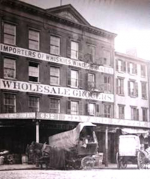 In 1881, the Rush family was forced to find a new home when produce merchant Hugh King took over 632 Hudson Street and its twin at 630 Hudson, built by Stephen Kane in 1847. The Esteve family purchased the buildings in the 1930s and for 40 years they housed their sausage factory.
In 1881, the Rush family was forced to find a new home when produce merchant Hugh King took over 632 Hudson Street and its twin at 630 Hudson, built by Stephen Kane in 1847. The Esteve family purchased the buildings in the 1930s and for 40 years they housed their sausage factory.
In 1889, 18-year-old John Rush got into trouble with the law when he was arrested for stealing some cash and promissory notes. He served three years of a four-year sentence at Sing Sing, and was pardoned by new Governor Roswell Pettibone Flower in 1892.
A year later, he joined the New York Fire Patrol No. 2. The fact that he lied on his civil service exam about prior felony convictions would come to haunt him briefly a few years later, but it never hurt his career.
It was during his service with the Fire Patrol that John Rush was discovered by members of the Fire Department for his many daring rescues.
 Members of the Fire Insurance Patrol, also referred to as the Fire Patrol or the Salvage Patrol, stood out from the regular fireman by their bright red helmets. Their well-equipped vehicles carried a 16-foot extension ladder, chemical extinguishers, hooks, axes, door-openers, brooms, shovels, buckets, ropes, and various other tools. Museum of the City of New York Collections
Members of the Fire Insurance Patrol, also referred to as the Fire Patrol or the Salvage Patrol, stood out from the regular fireman by their bright red helmets. Their well-equipped vehicles carried a 16-foot extension ladder, chemical extinguishers, hooks, axes, door-openers, brooms, shovels, buckets, ropes, and various other tools. Museum of the City of New York Collections
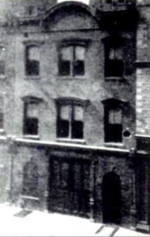
When John Rush joined Fire Patrol 2 in 1893, the company was stationed at 31 Great Jones Street in Greenwich Village. Formerly the Samuel W. Parmly stables, the NYBFU purchased the building in 1872 and converted it into a firehouse. Patrol 2 occupied this location until 1907. Today it is home to Vic’s Italian restaurant and apartments.
The New York Fire Patrol – officially the Fire Insurance Patrol — was organized in 1839 and funded by the New York Board of Fire Underwriters (NYBFU) to patrol lower Manhattan. The job of the patrolman or “Patrolio” was to discover fires and to prevent losses to insured properties.
The men worked alongside the volunteer firefighters, and, later, the paid firemen, and were in fact firefighters trained in the art of salvage and overhaul.
In 1867 a state charter was granted to the Fire Patrol to legally extinguish fires and conduct salvage operations throughout New York City. The New York Fire Patrol was the oldest paid fire service in the United States, and was the last insurance-funded fire salvage corps in the country when it was disbanded in 2006.
A year after he joined the Fire patrol, John Rush married Helen Patterson. Their daughter Sarah was born a year later – the same year that Patrolman Rush made his biggest fire rescue.
The daring feat took place on November 5, 1895, during a five-alarm fire that destroyed the Manhattan Savings Institution building and numerous other structures on Broadway and Bleecker Street.
John Rush and Patrolman Burnett were inside 648 Broadway when they heard two firemen shouting for help. The men had become trapped on the fifth floor of an adjacent building when the three upper floors fell in.
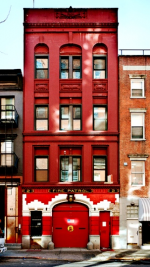 In 1906 architect Franklin Baylis began work on a new home for Fire Patrol 2 on the site of an old boarding house at 84 W. 3rd Street. The four-story brick structure served as their headquarters for the next 100 years. In 2010, Anderson Cooper purchased the building for $4.3 million. With assistance from architect Cary Tamarkin, Cooper converted the building to a private residence, leaving the exterior entirely intact and historically restored.
In 1906 architect Franklin Baylis began work on a new home for Fire Patrol 2 on the site of an old boarding house at 84 W. 3rd Street. The four-story brick structure served as their headquarters for the next 100 years. In 2010, Anderson Cooper purchased the building for $4.3 million. With assistance from architect Cary Tamarkin, Cooper converted the building to a private residence, leaving the exterior entirely intact and historically restored.
Rush and Burnett climbed out a window and balanced on a four-inch ledge and a small sign.
From there, the rescuers were still several feet below the trapped firemen, so Rush climbed onto Burnett’s shoulders and made a human ladder that just reached the firemen above him.
 The daring rescue took place between 648 and 646 Broadway, pictured here (middle and far-right buildings.) The fire patrolmen created a human ladder between the two buildings, allowing the trapped firemen to escape #646 and climb into a window in #648.
The daring rescue took place between 648 and 646 Broadway, pictured here (middle and far-right buildings.) The fire patrolmen created a human ladder between the two buildings, allowing the trapped firemen to escape #646 and climb into a window in #648.
The trapped men held onto Rush and were able to make their way into the window just above Rush and Burnett.
As
The New York Times reported, “It was a perilous undertaking, and it looked as though all would fall to the street.”
Seven months later, on June 8, 1896, John Rush was appointed to the New York Fire Department as a fireman for Engine Company No. 30.
He quickly advanced to the position of engineer (August 22, 1898), lieutenant (August 1, 1900), captain (April 15, 1904), and Battalion Chief, assigned to the Fifth Battalion (July 1, 1911).
While John was quickly rising among the ranks, tragedy struck time and time again on the home front. Sometime around 1907, John’s father was hurled from his fire engine on the way to a fire and killed instantly.
Soon after his father died, his wife took ill and was confined to a bed for three years. She died one month after he was promoted to battalion chief, in August 1911.
On January 9, 1912, John’s brother Charles E. Rush, a 35-year-old fireman with Engine Company No. 20, caught pneumonia while fighting the
historic Equitable Life Building fire. He succumbed to his illness, leaving a wife and family. With both his father and brother gone, John now had to help support his mother and sister-in-law as well as take care of his own teenage daughter.
Dies While Trying to Save Children
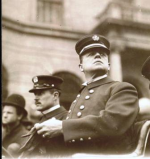 When Chief Edward Croker (front) asked for the best fireman to be his driver, Captain John Bush (back) came highly recommended. Whether driving the horse-drawn buggy or the motorized car, John had a reputation for driving fast. Museum of the City of New York Collections
When Chief Edward Croker (front) asked for the best fireman to be his driver, Captain John Bush (back) came highly recommended. Whether driving the horse-drawn buggy or the motorized car, John had a reputation for driving fast. Museum of the City of New York Collections
“It seems a strange irony of fate that a minor accident should have killed Chief Rush. I had almost come to think he bore a charmed life. One gets such ideas of men who pass through seemingly impassable dangers unscathed.”–Doctor Archer, St. Vincent’s Hospital, April 26, 1912
On April 25, 1912, John was being driven home in a horse-drawn buggy pulled by Victor. Victor was a large horse – more than 16 hands high – and had a reputation for being skittish. But John’s driver, John Harvey, was used to handling him.
The men had just passed Christopher Street when they got behind a truck, which caused Victor to get jumpy. The collar snapped under the strain and Victor plunged half out of his harness and raced toward a group of children who were crossing Hudson Street.
John Rush seized the reigns from his driver and pulled the horse back on his haunches to prevent a collision with the children.
The car reared and plunged, and the wheel of the buggy got caught in a car rail, causing the buggy to overturn. John and his driver were tossed from the vehicle. John Harvey landed on his feet.
John Rush plunged head first into the curb and fractured his skull.
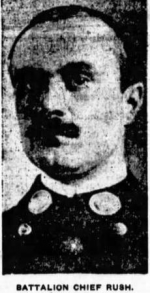 John Rush had served only 9 months as a battalion chief before his death in 1912.
John Rush had served only 9 months as a battalion chief before his death in 1912.
According to news reports, John Rush had only time to ask Harvey to send for ex-Chief Croker when he went unconscious. Father McGrath of the Seamen’s Mission, who happened to be passing, issued last rites of the Church.
Victor took off running, but he halted in front of Hook and Ladder Company 5 at 96 Charles Street, where Chief Rush often stopped during inspection tours.
Seeing the driver-less buggy, the men went running toward a crowd that was gathering on Hudson Street. Recognizing the seriousness of the case, the firemen insisted that Dr. Archer of the Fire Department and Dr. F. D. Smith be called. The two physicians hurried to St. Vincent’s, arriving there as soon as the ambulance pulled up.
After determining that Chief Rush’s skull had been fractured, Dr. Archer sent for Dr. Joseph Bissell and Dr. George Stewart. The four doctors were preparing the operating table at 3:20 o’clock when Chief Rush died. Ex-Chief Croker and John’s 17-year-old daughter, Sarah, were at his side. John Rush was buried at the New York Bay Cemetery in Jersey City.
